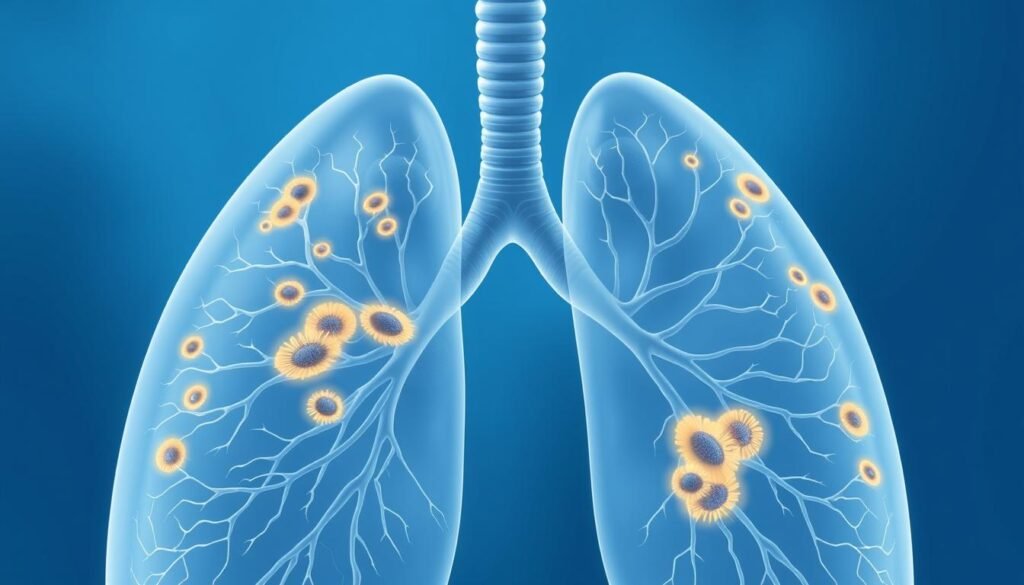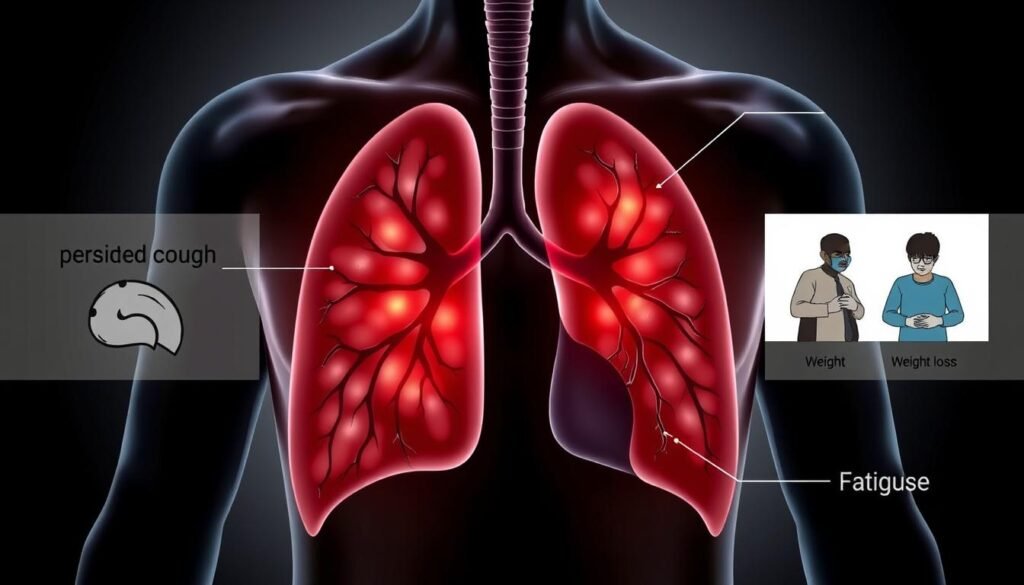Did you know small-cell lung cancer (SCLC) accounts for 10%-15% of all lung cancer cases? It’s a fast-growing cancer that spreads quickly. Many people don’t know they have it until it’s late. This makes knowing the early signs very important. It helps catch the disease early, making treatment more effective.
People often wait 2 to 3 months before getting help. This delay can make treatment harder. Being aware of the warning signs is crucial, especially if you smoke or used to smoke. Knowing the early symptoms of lung cancer means you can get help sooner. This could make your treatment work better.
Key Takeaways
- Small-cell lung cancer represents a significant percentage of lung cancer cases.
- Symptoms can persist for months before diagnosis; early recognition is vital.
- Awareness of early signs improves the chances of effective treatment.
- Smoking is a major risk factor for developing small cell carcinoma.
- Key symptoms include persistent cough, chest pain, and unexplained weight loss.
Understanding Small Cell Lung Cancer
Small cell lung cancer (SCLC) makes up around 10-15% of all lung cancer cases. It grows quickly and behaves differently from other lung cancers, like non-small cell lung cancer (NSCLC). SCLC comes in two main types: small cell carcinoma, also known as oat cell cancer, and combined small cell carcinoma.
The main cause of small cell lung cancer is tobacco smoking. Smoking is behind most cases. This aggressive cancer usually starts in the chest’s central parts, especially the breathing tubes. Often, by the time it’s found, it has spread to other organs.
Treatment for small cell carcinoma often includes chemotherapy, radiation therapy, and immunotherapy. Chemotherapy is usually the first treatment, while radiation might be added for limited-stage SCLC. Immunotherapy helps the immune system fight cancer. There are two staging categories: limited and extensive stage. They help doctors decide on the best treatment plan.
It’s crucial to understand small cell lung cancer for early detection and better patient results. Ongoing clinical trials are looking for new treatments to help those affected. Patients should talk with their doctors about all treatment options, including alternative remedies. For more information, check out the details about SCLC.
| Characteristic | Small Cell Lung Cancer | Non-Small Cell Lung Cancer |
|---|---|---|
| Prevalence | 10-15% of lung cancers | 85-90% of lung cancers |
| Growth Rate | Rapid | Slower |
| Main Treatment | Chemotherapy | Surgery, Chemotherapy, Radiation |
| Stage Categories | Limited and Extensive | Localized, Regional, Distant |
| Response to Treatment | Generally less favorable | Varies by stage |
The Importance of Early Detection
Finding small cell lung cancer early greatly improves how well patients do. It leads to timely treatments that can boost survival. In the United States, lung cancer ranks second in commonness and first in causing cancer deaths. Spotting the symptoms early is key to starting the right screenings and treatments.
The American Cancer Society strongly suggests lung cancer screening with low-dose CT scans. This is for people 50 to 80 years old who have smoked a lot. A pack-year means smoking one pack every day for a year. This helps doctors measure your risk. These scans are good at finding spots in the lungs that might be cancer.
Screening every year can save lives, especially for those at greater risk. These screenings use a bit more radiation than a chest x-ray but less than a regular CT scan. While LDCT scans can show areas of concern, it’s important to remember not all lung cancers are caught early. That’s why talking with healthcare experts about screenings is needed. They’ll discuss what screenings do, their pluses, and their limits.
Some people with lung cancer never smoked. This shows why all types of people need to know the symptoms of small cell lung cancer. Sadly, less than 25% of lung cancers are found early, affecting survival chances. Also, issues like uneven reporting and money problems make screening tough. Yet, sticking to suggested screenings can greatly help those at risk.
Common Lung Cancer Symptoms
Lung cancer often stays hidden until it’s quite advanced. Noticing common lung cancer symptoms early can make a big difference in getting help. Watch out for a persistent cough, chest pain, trouble breathing, and unexplained weight loss. These signs might point to other issues too, so getting a doctor’s opinion is key.
A persistent cough is a major lung cancer warning sign, especially if it gets worse. Don’t ignore chest pain. It could be a sign of lung cancer. Feeling short of breath can make everyday things hard, signaling the need to see a doctor.
Surprising weight loss should raise an alarm, particularly if there’s no clear reason. You might not feel like eating or start disliking some foods. If you spot these signs, getting help quickly could open up better treatment chances. For more details on lung cancer symptoms, check out this comprehensive resource.
| Symptom | Description |
|---|---|
| Persistent Cough | A cough that doesn’t go away or worsens over time. |
| Chest Pain | Pain in the chest that may feel sharp or constant. |
| Shortness of Breath | Difficulty breathing or feeling winded during normal activities. |
| Unexplained Weight Loss | Unexpected loss of weight without changes in diet or exercise. |
Talking about these symptoms early with doctors can help manage lung cancer effectively. This can lead to better treatment results.
Signs of Small Cell Lung Cancer
Early detection of small cell lung cancer is very important. The signs can be easy to miss at first but are serious. Knowing these signs can help catch the cancer early, which can lead to better treatment results.
Persistent Cough
A lasting cough is a key warning sign of small cell lung cancer. This cough may get worse over time. If you have a cough that does not go away after a few weeks, see a doctor.
Chest Pain
Chest pain is another important sign of small cell lung cancer. It happens when you breathe deeply, cough, or laugh. This pain shows the cancer might be spreading or irritating the lungs. If you have chest pain, understanding when and how it happens is important for diagnosis.
Shortness of Breath
Feeling short of breath can mean small cell lung cancer. It might happen when moving or even when still. If breathing is hard, it can mean the cancer is affecting your lungs. Anyone with this symptom should get medical help.

Additional Early Lung Cancer Signs
Recognizing early lung cancer signs can be crucial. Persistent coughing and chest pain are known indicators. However, coughing up blood and unexplained weight loss are significant warnings. They need immediate medical check-ups.
Coughing Up Blood
Coughing up blood is a serious symptom of lung cancer. It can be very alarming. If you experience this, get medical help right away. It could mean lung cancer or other serious problems.
Unexplained Weight Loss
If you’re losing weight without trying, it might be a concern. It can be a sign of lung cancer or other health issues. It’s important to see a doctor for these unexpected changes. They can help diagnose and start the right treatment early.
Symptoms Related to Respiratory Infections
Knowing the signs of respiratory infections is very important. This is because they can be linked to serious issues like lung cancer. People, especially those with small cell lung cancer (SCLC), might get a lot of respiratory infections. These include bronchitis and pneumonia. Sometimes, the effects of these infections can look a lot like lung cancer signs. This could lead to a wrong diagnosis if not spotted right away.
Repeated Bronchitis and Pneumonia
Long-term respiratory infections, like bronchitis and pneumonia, are big health risks. They bring on constant coughing, pain in the chest, and more phlegm. If it’s hard to get better from these infections, it might mean there are lung problems. This makes seeing doctors key when these signs don’t go away. Often getting bronchitis and pneumonia not only makes life harder but could also hint at worse issues, like lung cancer. To learn more about the early signs, check early symptoms of lung cancer.
Wheezing and Hoarseness
Wheezing is a high-pitched sound when you breathe. It happens when airways are tight because of swelling or blockage. Hoarseness means the voice cords are impacted. These signs can suggest a serious respiratory problem. They often come from respiratory infections and can really affect talking and breathing. If someone has ongoing wheezing and hoarseness that won’t stop, they should get checked by a doctor. These symptoms could mean there’s a bigger problem, like lung cancer, affecting their lungs.
Understanding Paraneoplastic Syndromes
Paraneoplastic syndromes are problems caused by cancer, like small cell lung cancer (SCLC). These issues begin when cancer cells make substances that mess up how the body works. This can cause many health problems. About 60% of people with SCLC may have Lambert-Eaton myasthenic syndrome (LEMS), which shows how common these issues are.
Some frequent paraneoplastic syndromes with SCLC are:
- Syndrome of Inappropriate Antidiuretic Hormone Secretion (SIADH)
- Cushing Syndrome
- Hypercalcemia
These health problems come from tumor-made hormones and can hide the real cancer cause with their symptoms. To find these syndromes, doctors may check for certain antibodies in spinal fluid. They also run blood tests and metabolic panels often.
Doctors use CT and PET scans to spot tumors causing these syndromes. An important issue is that even after taking out the tumor, nerve problems might stay. This can require treatments with medicines like corticosteroids and special IV fluids. Understanding and finding these syndromes early can help treat them better. This might even help people with SCLC live longer.
| Paraneoplastic Syndrome | Symptoms | Potential Complications |
|---|---|---|
| Syndrome of Inappropriate Antidiuretic Hormone (SIADH) | Hyponatremia, fluid retention | Seizures, confusion, coma |
| Cushing Syndrome | Weight gain, high blood pressure | Diabetes, cardiovascular issues |
| Lambert-Eaton Myasthenic Syndrome (LEMS) | Muscle weakness, dry mouth | Respiratory difficulties |
Advanced Symptoms of Small Cell Lung Cancer
As small cell lung cancer gets worse, patients may notice more advanced symptoms. These show the cancer has spread and become more severe. Bone pain and neurological changes are two major symptoms that need quick medical check-ups.
Bone Pain
When cancer reaches the bones, bone pain can start. It leads to discomfort and aches that affect everyday life. This pain can get worse, making life harder. It is very important to get medical help early if you have this pain, as it could mean the cancer has spread.
Neurological Changes
Neurological changes might include feeling dizzy, numb, or having trouble moving. These are signs that the cancer could be affecting your brain or nerves. If you notice these symptoms, seeing a doctor right away is key. Quick action can help manage the disease better.

| Symptom | Description | Implications |
|---|---|---|
| Bone Pain | Aches and discomfort linked to cancer spreading to bones. | Possible metastasis, requires immediate evaluation. |
| Neurological Changes | Includes dizziness, numbness, and coordination issues. | Potential impact on the central nervous system, urgent care needed. |
Risk Factors for Developing Small Cell Lung Cancer
Knowing the risk factors for small cell lung cancer helps with prevention. Smoking is the top risk factor, linked to 80% of lung cancer deaths. This is especially true for small cell lung cancer (SCLC), which is strongly connected to smoking. Secondhand smoke is also a big problem, being the third leading lung cancer cause in the US.
There are also environmental risks to consider. Radon is the second-leading lung cancer cause, especially among non-smokers. Working with asbestos also raises lung cancer risk. Asbestos exposure can lead to mesothelioma, a direct result of asbestos. Exposure to mining materials or dangerous chemicals like arsenic increases the risk too.
Some dietary supplements, like beta-carotene, might increase a smoker’s lung cancer risk. Drinking water with arsenic can also raise the risk. If someone had radiation therapy to the chest before, and they smoke, their risk goes up too.
Air pollution from diesel exhaust causes about 1% to 2% of lung cancer deaths in the US. Having a personal or family history of lung cancer adds to the risk. The effects of e-cigarettes are still being studied. The impact of smoking marijuana on lung cancer needs more research too.
| Risk Factor | Impact on Small Cell Lung Cancer |
|---|---|
| Smoking | Primary risk factor; accounts for 80% of lung cancer deaths. |
| Secondhand Smoke | Third leading cause of lung cancer. |
| Radon Exposure | Second-leading cause among non-smokers. |
| Asbestos | Significantly increases risk; related to mesothelioma. |
| Exposure to Chemicals | Inhalation of arsenic, beryllium, and uranium increases risk. |
| Radiation Therapy | Previous chest radiation increases lung cancer risk. |
| Outdoor Air Pollution | Contributes to 1-2% of lung cancer deaths. |
Being aware of these risks helps people take action for cancer prevention and better health.
How to Approach Your Doctor About Symptoms
When you think you might have lung cancer symptoms, it’s vital to talk to doctors confidently. Make sure to communicate well during medical visits. Keeping track of symptoms, when they began, and how long they last is helpful.
Talking openly about lung cancer symptoms is key. Feel free to ask questions and share your concerns without holding back. Before the visit, write down important points to discuss. This can include questions about tests, treatments, and changes you might need to make.
It becomes crucial to speak up if your symptoms get worse or change. A deep conversation about the meaning of these changes and how they might relate to small cell lung cancer is necessary. Looking at resources like advice on talking effectively can set you up for a meaningful talk.

Lastly, good communication builds trust and can lead to better care. By recording symptoms and keeping an open dialogue, you put yourself in a strong position to manage your health well.
Conclusion
Knowing signs of small cell lung cancer is essential. It helps people catch it early. This leads to better treatment results. Many signs might point to this cancer, like being out of breath and feeling very tired. These symptoms urge people to get checked by doctors.
Educating people on spotting lung cancer early is crucial. Efforts to increase public awareness help everyone understand the disease. This means people recognize signs earlier. Lung cancer is the top cause of cancer deaths globally. Quick action and regular checks can save lives.
The journey through lung cancer is hard on patients and their caregivers. They need continuous support and knowledge. Raising awareness and urging symptom checks can boost early detection. This approach aims for a healthier future and enhances life quality for those fighting lung cancer.